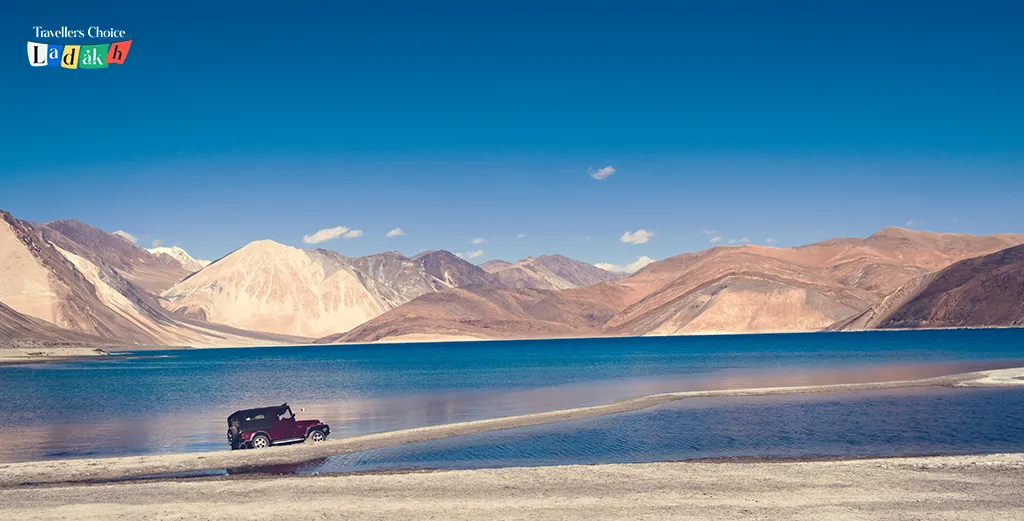Pangong Tso: A Lake Like No Other
Some locations will trigger an involuntary pause in your scroll- just a gaze. Pangong Tso is one of those places. Nestled between India and Tibet, this high-altitude lake is so blue, it feels photo-shopped. Not that it is photo-shopped, it’s actually 134 km of incredible, clean, and sparkling nature under the Ladakhi sky.
If you ever saw a traveler standing beside an endless horizon of blue, with mountain reflection so crisp the glass would be too scared to cut, chances are they were at Pangong Tso. Welcome to the location where the sky, water, and your camera lens make a pact that you don’t discuss.
The Lake That Changes Color Like It’s Showing Off
The first thing you’ll notice about this magnificent lake is that it can’t decide what color it wants to be. One hour it’s turquoise, the next it’s navy, and by evening it’s silver with a dramatic glow. Locals say it mirrors your mood. Scientists say it’s the minerals. Either way, it’s pure art in motion.
Stretching across 60 percent into Tibet, the lake sits at 14,270 feet above sea level, which means you’ll be short of breath for two reasons: the altitude and the view.
If you’re planning your trip, this little Pangong Lake travel guide will help you keep both awe and oxygen in balance.
Getting There: The Journey Is Half the Story
Reaching Pangong Tso isn’t just a drive; it’s a rite of passage. The road from Leh takes about five hours and goes over Chang La, one of the highest motorable passes in the world. You’ll see mountains, frozen streams, and maybe a yak or two that look far more comfortable in the cold than you ever will.
Tip: Start early. The roads are better in the morning, and you’ll want enough daylight to soak in the view without racing the sunset.
Camping by the Blue
Pangong Tso camping is as close as it gets to starring in your own travel film. Picture waking up to the sound of icy wind flapping against your tent while the sun turns the lake into liquid sapphire.
There are plenty of campsites along the shore, from cozy glamping tents with heaters to the “I-can-see-my-breath” variety for hardcore adventurers. Just remember: temperatures drop quickly after sunset, so bring layers, thermals, and possibly a sense of dread about how cold it can get in summer.
If comfort is your thing, a few eco-resorts near Spangmik village offer heated rooms and proper beds. If adventure calls louder than comfort, pitch your tent near the water and count stars until you forget which way is north.
Pangong Tso Photography: The Lake That Owns Your Camera Roll
You don’t have to be a professional to fall in love with Pangong Tso photography. The light here is crisp, clean, and occasionally too good to be true. Early morning or golden hour shots practically edit themselves.
A quick tip: The best reflections appear when the wind takes a break. And if you’re aiming for those classic “infinite blue” shots, move a bit away from the crowd. There’s enough shoreline for everyone to feel like an explorer.
Pro move? Capture a time-lapse from sunrise to sunset. Watching the colors shift is like seeing nature show off its entire wardrobe in one day.
Food, Facilities, and Finding Balance
The food scene here is simple. You’ll find steaming bowls of Maggi, momos, or butter tea, exactly what your frozen fingers need. Portable toilets and basic washrooms are available at the camps, but this isn’t a luxury resort setup.
That said, what Pangong Tso lacks in creature comforts, it makes up for in silence, space, and stars. It’s one of those rare places where doing nothing feels like the ultimate activity.
When to Visit: Timing Is Everything
The best time to visit Pangong Tso is from May to September. During these months, the roads are open, the weather is bearable, and the lake shows off its trademark shades of blue.
From November to April, the lake freezes solid, yes, you can literally walk on it, but travel is restricted, and temperatures can turn you into a popsicle.
Responsible Travel: The Lake Deserves Respect
It’s tempting to take that perfect selfie, but remember this isn’t a movie set. Carry reusable bottles, avoid littering, and don’t step too close to the fragile shoreline. The region relies on eco-tourism, and the locals are doing their best to keep this piece of heaven clean. A little effort goes a long way.
The Hidden Side of Pangong Lake
Beyond the usual photo ops, there’s more to explore. Villages like Spangmik, Merak, and Man offer glimpses of blue waters Ladakh life, simple, quiet, and deeply connected to the land. Chat with locals, sip butter tea, or just sit and watch clouds crawl across the sky.
And if you’re extending your lake tours India itinerary, combine Pangong with Tso Moriri or Tso Kar for a trio of Himalayan beauty that’ll make your camera battery give up before you do.
Final Ripple
So here’s the thing, Pangong Tso isn’t just another pretty lake. It’s a feeling. The silence, the shimmer, the sheer otherworldliness of it stay with you long after you’ve left.
Whether you’re camping under a million stars, chasing reflections with your camera, or simply sipping tea while watching the waves, this lake doesn’t just show you Ladakh; it humbles you with it.
If you ever need help figuring out routes, stays, or where to find that perfect view, Traveller’s Choice Ladakh can set you up with local insights and experiences that go beyond the usual itinerary.
Pack your jacket, charge your camera, and let Pangong Tso remind you how beautiful stillness can be.
